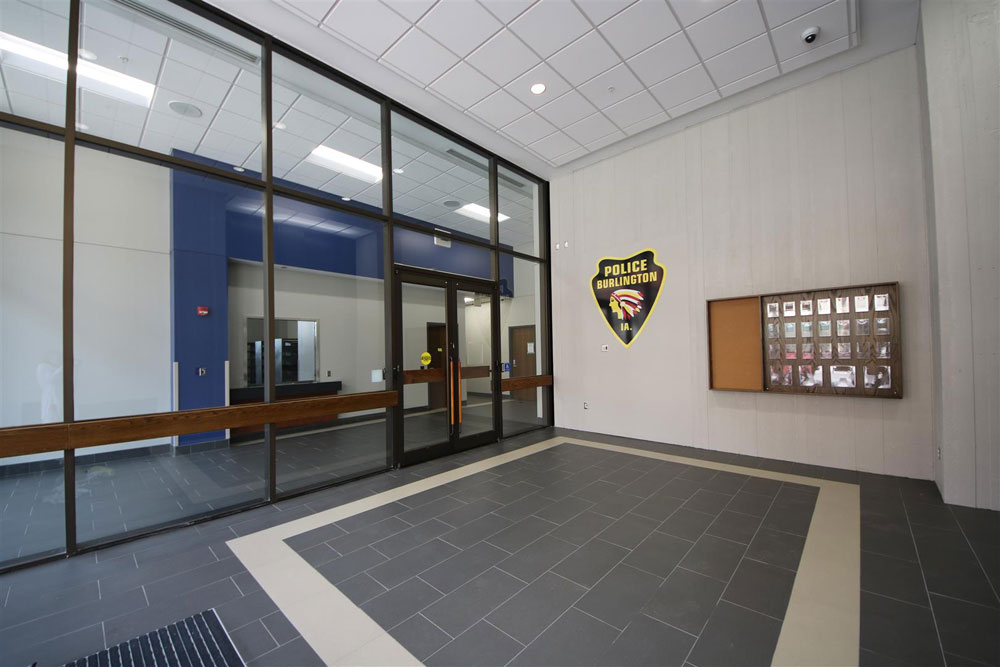Remodeling? Navigate existing building code
 Carl A. Nelson & Company converted the former U.S. Bank building at Jefferson and Main streets in downtown Burlington, Iowa, for use as the new headquarters building of the Burlington Police Department.
Carl A. Nelson & Company converted the former U.S. Bank building at Jefferson and Main streets in downtown Burlington, Iowa, for use as the new headquarters building of the Burlington Police Department.
5 years, 9 months ago

By Cindy Larson, Licensed Architect, NCARB
Nelson Design, Inc.
All building Owners want safe buildings for their occupants. However, the code-defined threshold for safe buildings has evolved over time. In general, if you do not alter your building, you are not required to comply with the International Building Code (IBC) which is intended for new buildings, building additions and extensive alterations. Likewise, if you do not alter your building or change the occupancy, you are not required to comply with the International Existing Building Code (IEBC) which is intended for limited alterations of buildings or changes in building occupancy. This is in contrast to most fire code regulations which typically apply to existing buildings. The 2015 IEBC recognizes that altering existing buildings to meet code requirements of new construction may not be feasible in most situations. Therefore, depending on the building construction type, the proposed alterations, and occupancy, the IEBC permits solutions that would not comply with the IBC.
The IEBC has the following strategies that can be used when evaluating alterations to an existing building for code compliance when requesting a building permit.
1. Prescriptive Compliance Method
2. Work Area Compliance Method
3. Performance Compliance Method
It is not acceptable to mix and match different requirements from the different methods.
Prescriptive Compliance Method
Buildings using this strategy must meet every requirement of Chapter 4 of the IEBC. This chapter often refers back to the IBC (new construction building code) for code requirements with a few exceptions for existing conditions. Some of these exceptions include building materials, structural design, window replacement, and accessibility. This strategy requires working closely with the Building Official and relies on their judgement for “technical infeasibility” and “no less conforming.” It is the least used of the three methods for existing buildings.
Work Area Compliance Method
This method is based on the type of work and how much area is being disturbed. The less work that is being done to the building, the fewer alterations are needed to be code compliant:
1. Repairs – “The work shall not make the building less conforming than it was before the repair was undertaken. (601.2)”
2. Alteration Level 1 – “An existing building or portion thereof shall not be altered such that the building becomes less safe than its existing condition.”
3. Alteration Level 2 – “All new construction elements, components, systems, and spaces shall comply with the requirements of the IBC (new construction building code) (801.3).” With the exception that buildings in which the reconfiguration is exclusively the result of compliance with the accessibility requirements can follow requirements of Alteration Level 1 (801.1)
4. Alteration Level 3 – Follows IBC with a few exceptions.
5. Change of Occupancy – Follows Alternate Level 3 requirements (1012.1.1) except for a few high-risk occupancies which requires the code review to follow the IBC in its entirety (1002).
6. Additions – Must follow IBC, but does not trigger the rest of the existing building to follow the IBC. However, the addition cannot make the existing building less safe for example, by extending corridors, or blocking exits.
7. Historic Building – “Conditions determined by the code official to be unsafe shall be remedied. No work shall be required beyond what is required to remedy the unsafe conditions. (1202.2, 1206.2).” There are also exceptions for egress, sprinklers, and fire rating of walls and ceilings.
8. Relocated or Moved Building – Shall meet the requirements of the IEBC Work Area Compliance based on the amount of Work Area defined above, or historic building status. There are some additional requirements in this section which include new foundations, and location on lot.
Performance Compliance Method
This method allows for exceptions the Work Area Compliance Method does not allow (1401.1). This method only applies to the following occupancies: Assembly; Business; Education; Factory; Institution Level 2; Mercantile; Residential and Storage. “Investigation and analysis must include fire safety, means of egress, and general safety (1401.5)” to evaluate the safety of the building. The evaluation results in a building score based on Chapter 14 of the IEBC. If the sum of the score is greater than zero then the building is considered safe. However, “Buildings that are evaluated in accordance with this section shall comply with the International Fire Code and International Property Maintenance Code (1401.3.2).” Using this method allows some code requirements that are cost-prohibitive to not be implemented when other code requirement minimums are exceeded.
ABOUT THE AUTHOR
Cindy Larson is a licensed architect in Iowa, who first joined Carl A. Nelson & Company in 2004 after graduating from the University of Illinois-Champaign/Urbana with master’s degrees in business administration and architecture. She initially served as a project engineer then director of business development. In May 2019, she joined Nelson Design, Inc., a wholly owned subsidiary of Carl A. Nelson & Company, as a project manager. To learn more, contact Cindy or Nelson Design, Inc., architect Ellen McCulley at 319-754-8415; or write to canco@carlanelsonco.com